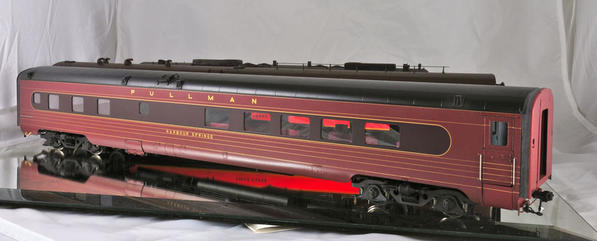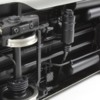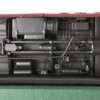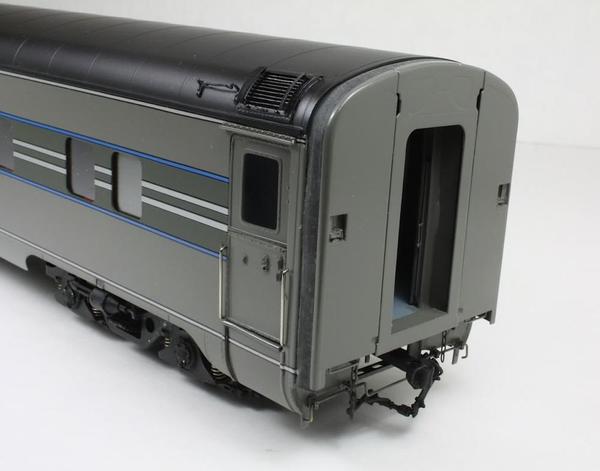So, the Lionel Smithsonian observation cars are Thousand Islands and Manhattan Island. Anyone know if the cars FAM subsequently released had any other names?
Replies sorted oldest to newest
You could take a look here for a complete Lionel Smithsonian and FAM passenger car overview: http://www.kohs.com/FAM_Passenger_Car_Reference.html
Which one were actually made I do not know; I have a Thousand Islands obervation so that was made anyway:
Regards
Fred
Fine Art Models offered the Lionel-Smithsonian 20th Century Limited in serialized subscription sets with equipment named for the inaugural eastbound and westbound streamlined trains that ran on June 15, 1938, so they would only have made the two obsevation cars originally assigned on that day.
Set serial numbers were awarded by lottery, and while a subscriber was not required to buy the entire train, he would only receive pieces serialized with a single number unless he had actually ordered multiple sets. At $2500 for an engine and $500 per car this was expensive stuff, especially in the early 90s, so some of it inevitably made it's way into the secondary market rather early, resulting in sets being assembled or completed with mixed serial numbers.
Production was limited to a total of 500 sets, and complete sets ran to 13 cars each. It's doubtful that that many were actually ordered or built.
Crank
Truly these are the best domestic passenger car models ever produced.
Thanks to all who responded. I am familiar with the all the specifics of the Lionel Smithsonian cars. What I am not all that familiar with are the cars that FAM did beyond the Lionel cars other than there were an additional number of cars that they made and sold under the FAM name, as were all the Broadway Limited cars that Lionel never bought into and FAM never finished all the cars. I have read FAM made additional names of cars for people who wanted to expand their sets beyond those names sold by Lionel but I don't know any more specifics of those cars. I also believe that the two original Island cars are the only ones that ever existed and River series observations were used subsequently.
Since Gary Kohs has recently passed away, I think it is a pretty safe bet that the only person likely to be able to answer your question is his brother George. He has contact information on his website.
Simon
Simon Winter posted:Since Gary Kohs has recently passed away, I think it is a pretty safe bet that the only person likely to be able to answer your question is his brother George. He has contact information on his website.
Simon
Been there, done that. George says he knows no more than is on the Koh's website.
Also found out there was a Pelee Island observation car.
rdunniii posted:Simon Winter posted:Since Gary Kohs has recently passed away, I think it is a pretty safe bet that the only person likely to be able to answer your question is his brother George. He has contact information on his website.
Simon
Been there, done that. George says he knows no more than is on the Koh's website.
Also found out there was a Pelee Island observation car.
Too bad, that! There is a dearth of information out there on "O" scale in general!
I looked at Dan Glasure's "Brass Guide" on Brass Trains dot com and found:
Set 1 composed of:
Westchester County 13 DBR
City of Indianapolis 17 roomette sleeper
Cascade Glory 10-5 sleeper
Imperial Castle 4-2-4
SET 2 composed of:
Century Club Dormitory Lounge Car
#680 Dining Car
#5020 RPO
Manhatten Island Observation
All others were single cars:
Club Car
Imperial Mansion 4-2-4 Sleeper
Cascade Valley Sleeper
City of Chicago 17 roomette sleeper
Obviously no new observations
The only other source for info. I know is Ebay
Simon
I have several of the add on sleepers for my transcontinental cars. I spent a great deal collecting them as they are rather difficult to find. One I’ve bought don’t recall the name an Imperial 4-4-2 I’ve never seen again. I did repaint one to a later scheme for my 1941 Chief
I love these models. Too bad I don’t Model eastern I would certainly have a complete consist. Beautiful models. I can’t tell the FAM from the Lionel in quality
Attachments
Attachments
They might have added "Maumee River" PSO 2 double bedrooms, 1 compartment, 1 drawing room. It was spotted on Eastbound train #26 on September 26, 1943, departing Chicago. It was headed by J-3a NYC 5450 pulling baggage-mail and 16 cars.
Other real 20th Century observations were 1930 "Mohawk Valley", 1938 "Elkhart Valley", 1965 "Hickory Creek"
Woodshire Bill posted:They might have added "Maumee River" PSO 2 double bedrooms, 1 compartment, 1 drawing room. It was spotted on Eastbound train #26 on September 26, 1943, departing Chicago. It was headed by J-3a NYC 5450 pulling baggage-mail and 16 cars.
Other real 20th Century observations were 1930 "Mohawk Valley", 1938 "Elkhart Valley", 1965 "Hickory Creek"
Guessing that the real names outnumbered those used for models. Whatever the case, the models are superb.
Simon
I'm going to be looking for either observation, swapping a Niagara County for a Weschester County (to have two Counties in the consist) and selling a Cascade Grotto after I find the others. Other than that I have everything. I had everything before but sold some of it because it was a steam powered train but making a Lark or an Overland ala 1950 kinda requires steam sooo... 3 steam powered streamliners it is.
Woodshire Bill posted:They might have added "Maumee River" PSO 2 double bedrooms, 1 compartment, 1 drawing room. It was spotted on Eastbound train #26 on September 26, 1943, departing Chicago. It was headed by J-3a NYC 5450 pulling baggage-mail and 16 cars.
Other real 20th Century observations were 1930 "Mohawk Valley", 1938 "Elkhart Valley", 1965 "Hickory Creek"
The 1938 streamlined consist was only one of the Island observations. The River and subsequent streamlined observations started in 1939 or later.
Note the English spelling of Harbor (Harbour) in Eric's photo of the FAM PRR lounge car. That aside they were indeed beautifully built models. I never weighed mine but they were by far the heaviest passenger cars I ever ran on the railroad. On other than a flatland model railroad the Lionel Smithsonian streamlined K4s would face a real challenge pulling a prototype length 7 or 8 car FAM Broadway Limited.
I would have hoped they'd roll as well as the Wasatch trucks that I read about. Don't they have roller bearings inside?
I'm guessing that the roller bearings would help with the extra weight?
Keystoned Ed posted:On other than a flatland model railroad the Lionel Smithsonian streamlined K4s would face a real challenge pulling a prototype length 7 or 8 car FAM Broadway Limited.
Hello Ed and Happy New Year!
What do you think the fix might be? I am guessing a stronger can motor. I know you had one that was redone!
Simon
rdunniii posted:...... I also believe that the two original Island cars are the only ones that ever existed and River series observations were used subsequently.
Per Wayner Car Names..., There were four Islands built for the 38 Century -- the three you mentioned plus Bedloes Island. In 1942 they were sidelined for the duration of the war and replaced by the three Rivers which had been built in 39 for the Southwestern Limited. Both types were sleeper - buffet lounge, but the Rivers had greater revenue space. [ I only looked this up because when I see "NYC River", I think 10-6 .....]
Best, SZ
Engineer-Joe posted:I would have hoped they'd roll as well as the Wasatch trucks that I read about. Don't they have roller bearings inside?
I'm guessing that the roller bearings would help with the extra weight?
Yes, they have roller bearings. But i think the cars weigh 2-3 pounds each. Most roll freely but some not as much.
rdunniii posted:Engineer-Joe posted:I would have hoped they'd roll as well as the Wasatch trucks that I read about. Don't they have roller bearings inside?
I'm guessing that the roller bearings would help with the extra weight?
Yes, they have roller bearings. But i think the cars weigh 2-3 pounds each. Most roll freely but some not as much.
2009 Golden Gate Depot 1938 20th Century Limited passenger cars weighed 3 lbs. 13 oz. each. A complete set of twelve requires 6.25 lb of tractive effort to pull them on a 2.2% grade, 2 Lb. to get them rolling and 4 Lb to lift them.
One Sunset E7 with a powerful horizontal drive motor can pull five cars. Therefore, three SS E7 engines are required on grade. A single die cast Lionel ES44AC with china drives can handle the entire consist.
The problem with the E7 engines is with the light weight, not the motors. Under moderate load, the E7s, even with traction tires, sit on the track spinning their wheels. No matter how low the static or rolling friction, moderate grades on layouts are the real performance killers.
That's one reason to model the NYC water level route rather than the PRR mountain road.
Woodshire Bill posted
The problem with the E7 engines is with the light weight, not the motors. Under moderate load, the E7s, even with traction tires, sit on the track spinning their wheels. No matter how low the static or rolling friction, moderate grades on layouts are the real performance killers.
That's one reason to model the NYC water level route rather than the PRR mountain road.
This is the 2 rail forum! We don't do no stinkin' traction tires! ![]()
![]()
![]()
![]()
![]()
![]()
Simon Winter posted:
Woodshire Bill posted
The problem with the E7 engines is with the light weight, not the motors. Under moderate load, the E7s, even with traction tires, sit on the track spinning their wheels. No matter how low the static or rolling friction, moderate grades on layouts are the real performance killers.
That's one reason to model the NYC water level route rather than the PRR mountain road.
This is the 2 rail forum! We don't do no stinkin' traction tires!





Do you not follow the difference between a dependent ",even with traction tires," and independent clause?
![]()
How many E7 units do you imagine it might take to generate 6.25 lbs of drawbar pull on a 2 rail scale track with a 2.2% grade.
But we stray from naming observation cars.
Simon - If I still had the Smithsonian K4s (modified with a PSC mechanism) and FAM Broadway cars it would have been fun to run some tests. I sold the locomotive and FAM cars as they didn't "fit" with the other rolling stock on my postwar era railroad.
The detail on FAM cars is amazing. They have hinged 3 piece full width diaphragm striker plates and two roofs - inner and outer. The trucks roll very well but they bodies are extremely heavy - I'd guess twice as heavy as a GGD model of the same prototype. Perhaps someone that has a car would would weight it and share the info.
Hello Ed,
I doubt I'll ever own any of the Fine Arts cars because of their cost, though I do agree that they are spectacular. I recall you mentioning that you had obtained a FA K4 shell and had modified or changed the drive. You have answered that question: PSC drive. Thanks!
Simon
Woodshire Bill posted:Simon Winter posted:
Woodshire Bill posted
The problem with the E7 engines is with the light weight, not the motors. Under moderate load, the E7s, even with traction tires, sit on the track spinning their wheels. No matter how low the static or rolling friction, moderate grades on layouts are the real performance killers.
That's one reason to model the NYC water level route rather than the PRR mountain road.
This is the 2 rail forum! We don't do no stinkin' traction tires!





Do you not follow the difference between a dependent ",even with traction tires," and independent clause?
How many E7 units do you imagine it might take to generate 6.25 lbs of drawbar pull on a 2 rail scale track with a 2.2% grade.
But we stray from naming observation cars.
Bill,
When I was a young lad, I had several Lionel trains, NOT A ONE OF WHICH WAS EQUIPPED WITH TRACTION TIRES, and they all ran fine. Wondering why they (traction tires) are necessary now?
All my stuff is 2 rail which is also NOT equipped with traction tires, so why are we discussing them here on the 2 rail forum?????
I will NEVER own an engine with traction tires, and they are in my opinion, like teats on a boar hog.
If an engine can't make a grade, I will modify it, or add another unit to the train.
Simon
The OCS Microcast “casted by” heheh ... are roller bearing trucks just like Wasatch.
The 1938 20TH century offered by 3rd Rail was too heavy for any brass steamer that I had, or even a cast MTH engine, and my layout is level. Each car did weigh over 3 lb. and a few were close to 3.5 lb. It is a great looking train, but the weight concentration was a block of brass? at each end of each car. Another problem was that wipers were used on the back of each wheel on each car. I had wipers on an old train previously, and the squeaking, in spite of constant lubrication, was intolerable. The wheels were soft enough that the wipers wore grooves in the wheels. I did not keep the Century long enough for this problem to reoccur. The wipers did create a lot of additional drag on the 3rd Rail train. If a lighter material could have been used for the ends of each car, and he would have used the insulated wheel pickup scheme, the train could be pulled by almost any engine assuming a weight per car of about 2.5 lb and preferably less. Two ill advised manufacturing decisions by the builder, in my opinion. The colors, painting, names, etc are excellent in all other respects. I personally wish he would reissue these with these two problems corrected, and the addition of LED lighting with an On-Off switch on each car. (My track stays much cleaner if I limit amperage to 2 amps or less...and the lighting is not very impressive unless the layout is dark.) I have three Dreyfuss Hudsons, and no train for them to pull.....
"If an engine can't make a grade, I will modify it, or add another unit to the train."
That is fine and certainly your choice to do that, but some are not into the toy train operation and want to run prototypical consists like the Century and Broadway did in the early years of the program. One steam engine and a typical consist. I will take a rubber tire(s) for realism and operation over adding multiple steam engines or running an overly short train giving it the toy train look, any day. Diesels, that is another story.
Charlie
Charlie posted:I will take a rubber tire(s) for realismCharlie
I don't think either the Twentieth Century or the Broadway Limited had rubber tires.
Simon
They did not pull five cars with a single engine either.
When I can get the tractive performance on 2 rail scale track that I enjoy on 3 rail, I'll be converting over. I appreciate others commenting on the Sunset 1938 20th Century Limited cars and expressing sentiments I agree with that have caused consternation and frustration. I re-weighed a car on a digital scale and it came out to a tad under 58 ounces.
After seven years of owning these cars, I finally came up with a partial solution to run this consist using the correct motive power, but in excess. It did require six MTH Z-4000s in parallel with three Lionel ZW-Ls and generating up to sixteen amps when the entire consist is on 2.2% grade.
Now ignore the 3rd rail, ignore the required extra loco, ignore anything else that is annoying, and concentrate on the 1938 Manhattan Island observation car which is in the topic of the thread.
Woodshire Bill posted:
rdunniii posted:Engineer-Joe posted:I would have hoped they'd roll as well as the Wasatch trucks that I read about. Don't they have roller bearings inside?
I'm guessing that the roller bearings would help with the extra weight?
Yes, they have roller bearings. But i think the cars weigh 2-3 pounds each. Most roll freely but some not as much.
2009 Golden Gate Depot 1938 20th Century Limited passenger cars weighed 3 lbs. 13 oz. each. A complete set of twelve requires 6.25 lb of tractive effort to pull them on a 2.2% grade, 2 Lb. to get them rolling and 4 Lb to lift them.
I replaced my non working scale and found the FAM cars each weight 5 lbs 5 ounces. So a 13 car train weighs about 70 lbs for any locomotive to pull.
Had there been any significant grades on the prototype route I doubt a single Hudson could have kept the speed up.
So I'm guessing FAM never made the Pelee or Bedloe's Island cars. Bummer.
Regarding the oh-so-heavy 3rd Rail cars. Other than the ends, what else on these cars, excluding the shells, makes them so heavy?
If they were mine, I'd look at using an end, or ends if they are different, to make a mold and cast them in resin. Ditto for any other fishing sinker components.
Alternatively, create 3D CAD models, print them and offer them for sale to the rest of the community.
Charlie posted:They did not pull five cars with a single engine either.
Agreed! ![]()
Woodshire Bill posted:
When I can get the tractive performance on 2 rail scale track that I enjoy on 3 rail, I'll be converting over. Now ignore the 3rd rail, ignore the required extra loco, ignore anything else that is annoying, and concentrate on the 1938 Manhattan Island observation car which is in the topic of the thread.
Bill, I know a lot of other 2 railers and I don't recall any of them complaining much about traction issues, which I think are mainly solved by weighting the engine.
As for annoying, none of this annoys me, as it is just a lively discussion. The cars originally being discussed were not Sunset, but Fine Arts Models, which are real Lead Sleds at 5.5 lbs.
RDUNNIII: "I replaced my non working scale and found the FAM cars each weight 5 lbs 5 ounces. So a 13 car train weighs about 70 lbs for any locomotive to pull."
I doubt any stock model is pulling them up a grade!
Cheers,
Simon
There is no law that says you cannot have traction tires on 2-rail. I would never do it, since my hobby is steel wheels on steel rail ( I do cut my drivers out of iron, which is a lot like traction tires). But all must admit - a traction tire here and there is not the visual jolt of three rail track and giant flanges! Opinion.
bob2 posted:There is no law that says you cannot have traction tires on 2-rail.
Correct, there is no law against being stupid.
Hey Bill, LOVED the video. Made my day. Enjoying your beautiful trains. Neato!
















